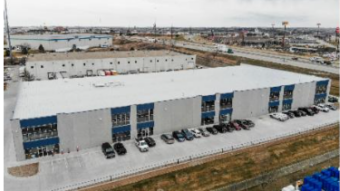For years, the e-commerce revolution has been a disruptor to the retail and industrial real estate markets, slowly chipping away at the former and bolstering the latter. There’s nothing slow about it now, as shelter-in-place orders brought on by the COVID-19 pandemic have rapidly accelerated this trend.
Despite conventional wisdom, it’s not a one-to-one market share conversion. A new report from Prologis digs into the intensity-of-use ratio between e-commerce and brick-and-mortar sales, as well as how the supply chain is impacted by changing consumer habits.
Since 2007, Prologis has been surveying customers about their activity levels and facility use, benchmarked in their Industrial Business Indicator (IBI). The IBI not only provides standardized analysis of industrial and retail real estate market cycles, it is a fair indicator of industry sentiment.
Prologis’ IBI bottomed out in April to a record low 25.8 (a metric of 50 is neutral, seasonally adjusted). However, those numbers rebounded in May to 45. Though this represents a contraction of warehouse activity, the V-shaped improvement suggests that economic slowdown—as well as reduced demand for logistics-related real estate—will be short lived.
The survey saw space utilization tick up moderately to 84 percent from April to May, though this metric remained approximately 150 basis points below its pre-Covid-19 level. In particular, retail customers reported the highest utilization rate, with 84.6 percent in May.
This aligns with a wider adoption of e-commerce among late adopters, as the pandemic has temporarily shuttered storefronts in most markets. This factor, along with increased inventories, is likely putting upward pressure on space utilization even as net activity falls.
The Prologis survey found that approximately two-thirds of firms have some sort of COVID-19 operational safety measures in place like staggered shifts; around 5 percent of respondents had suspended operations. For these two groups, their IBI registered below 40. For the 28 percent of respondents that have seen their business continue as usual, the average IBI came in closer to 60.
In addition to their typical role as a point of sale, brick-and-mortar stores warehouse physical goods, both on the shelves and in back storerooms. The year-after-year shift to online sales has led to a three-fold increase in warehouse demand among retailers.
Prologis looked at the top 30 retailers in the country and found that their logistics footprints grew in 2019 by 9 percent—an uptick from the 6 to 7 percent annual growth that these retailers reported in the prior five years. The reallocation of product from store shelves to warehouses provides retailers with both larger and more varied inventories, as well as greater efficiencies than they ever had in storefronts.
Data from Adobe’s Digital Economy Index showed that e-commerce ascended by 49 percent in April, spurred on by shelter-in-place restrictions. Much of this activity surrounded online grocery shopping, but it also acted as a point of entry to previously resistant online shoppers. Prologis research suggests that e-commerce penetration may level off at 20 percent by the end of 2020, compared to the pre-pandemic levels of 16.9 percent.
This growth in online sales will necessitate additional investments in fulfillment capabilities. For the past five years, e-commerce has required between 3.0 and 3.5 times the warehouse space of traditional brick-and-mortar—suggesting that supply chains are far from optimized. Once we have gotten past the pandemic, there should be a focus on more resiliency with the supply chain.




